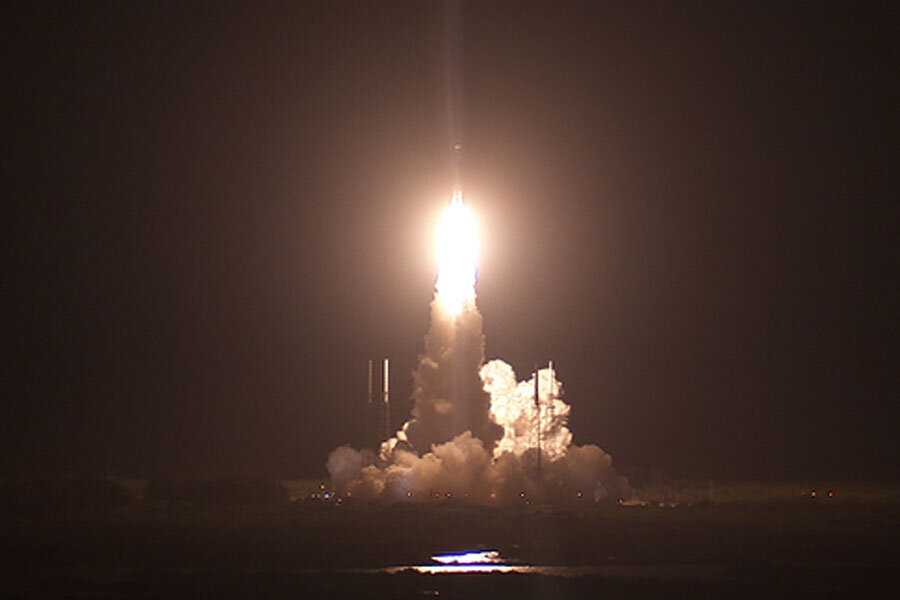'Picture perfect' Atlas V launch sends four NASA satellites into orbit
Loading...
| Cape Canaveral, Fla.
An umanned rocket lit up the night sky over Florida like a larger-than-life roman candle Thursday night (March 12), carrying a four satellites on a mission to seek an explosive phenomenon in Earth's magnetic field.
The United Launch Alliance Atlas V rocket blasted off from a launch pad here at Cape Canaveral Air Force Station at 10:44 p.m. (0244 p.m. GMT March 13), sending NASA's four Magnetospheric Multiscale satellites (MMS) on their way to hunt for magnetic reconnection events in Earth's magnetic field. NASA captured spectacular video of the nighttime MMS satellite launch.
NASA launch manager Omar Baez said it was a "picture perfect" launch for the Atlas V and the four MMS satellites. "Everybody is cheering and it appears that all four are where they need to be," Baez said after the launch. [See more launch photos for NASA's Magnetospheric Multiscale Mission]
Roughly 3,850 people were expected to watch the launch from the Kennedy Space Center campus and the Banana Creek, NASA Causeway as the Atlas V streaked into the clear, windy night sky over Florida.
The Atlas V was carrying four satellites that comprise the Magnetospheric Multiscale mission, or MMS, which will orbit together through the Earth's magnetic field. The $1.1 billion MMS mission will study a phenomenon known as magnetic reconnection, the key driver of what is known as space weather, which includes solar flares and coronal mass ejections, as well as geomagnetic storms and the auroras at the north and south poles. These events can damage human-made satellites and create electric surges in power grids on the ground.
John Durelli, an MMS scientist at the NASA Goddard Space Flight Center, said "the whole MMS team" came to Florida to watch the launch, many of them with their families. When asked how he was feeling about the launch, Durelli said he and his colleagues were using the phrase, "euphora-terror."
"Some people have been [working on MMS] for 10 years, so it's been a long time in development," Durelli said. "You have this combined feeling: you can't believe it's finally happening, but also, 'Oh my god! What if something goes wrong!'"
MMS is the only space experiment dedicated solely to studying magnetic reconnection. This process occurs when magnetic field lines break and reconnect in the presence of plasma. The magnetic fields release huge amounts of energy that can accelerate the plasma to nearly the speed of light. The four MMS satellites were built and tested at NASA's Goddard Space Flight Center in Greenbelt, Maryland. Multiple institutions and universities contributed to the science and instrumentation on the MMS satellites.
It is not yet known how the energy from magnetic field lines is transformed into heat and kinetic energy during magnetic reconnection, the mission scientists say. The four MMS satellites will fly in a pyramid shape, which will allow them to take data on magnetic reconnection events in three dimensions. The satellites will observe these extreme events all the way down to the level of electrons — a resolution 100 times higher than previous experiments that have observed this phenomenon, according to MMS scientists.
Follow Calla Cofield @callacofield.Follow us @Spacedotcom, Facebook and Google+. Original article on Space.com.
- Lift-Off! NASA Launches MMS Satellite Quartet | Video
- 'Don’t Cross The Streams!' NASA Studying Magnetic Explosions | Video
- The Sun's Wrath: Worst Solar Storms in History
- Satellite Quiz: How Well Do You Know What's Orbiting Earth?
Copyright 2015 SPACE.com, a Purch company. All rights reserved. This material may not be published, broadcast, rewritten or redistributed.





